Saudi Arabia Defense Market Size
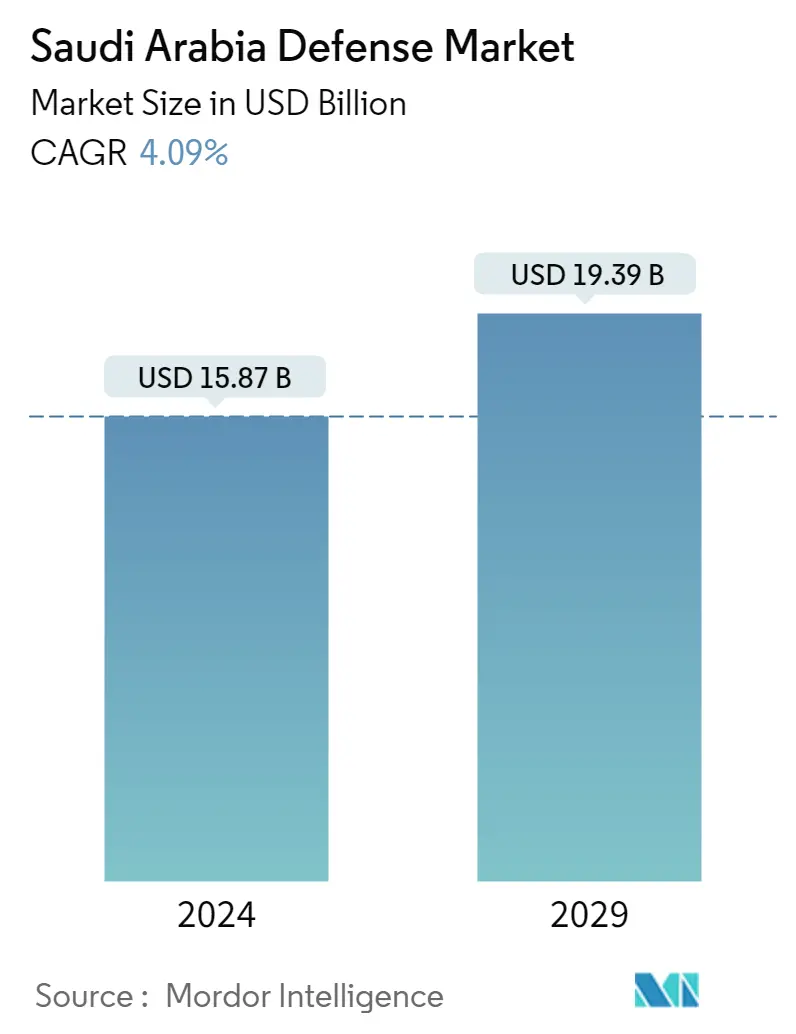
| Study Period | 2018 - 2028 |
| Base Year For Estimation | 2021 |
| Forecast Data Period | 2023 - 2028 |
| Market Size (2023) | USD 15.25 Billion |
| Market Size (2028) | USD 18.63 Billion |
| CAGR (2023 - 2028) | 4.09 % |
Major Players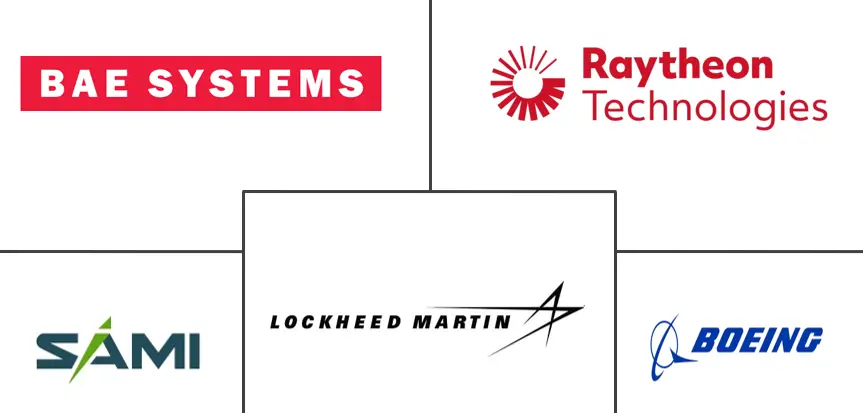
*Disclaimer: Major Players sorted in no particular order |
Need a report that reflects how COVID-19 has impacted this market and its growth?
Saudi Arabia Defense Market Analysis
The Saudi Arabia Defense Market size is estimated at USD 15.25 billion in 2023, and is expected to reach USD 18.63 billion by 2028, growing at a CAGR of 4.09% during the forecast period (2023-2028).
The country's economy witnessed a decrease of about 4% in 2020 due to the impact of COVID-19. However, as the country's oil output increased as well as the economy from non-oil activities, its growth returned to pre-COVID levels in 2021. Due to this, the procurement and R&D investments in the defense sector are expected to improve in the coming years.
The country is one of the top military spenders globally and the primary importer of arms from the United States. The high defense spending of the country (due to its robust economy and high GDP) has made the market lucrative for several local and foreign players. Several joint venture agreements have been signed since establishing the Saudi Arabian Military Industries (SAMI).
Over the past decade, political tensions in the Middle East have resulted in the country investing more in the defense sector. Saudi Arabian government has plans to modernize its military by 2030 and is procuring new fighter jets, surface combatants, and armored vehicles. It has also increased its focus on C4ISR and cybersecurity solutions in recent years.
However, in the past three years, the government reduced its defense spending to focus more on the education sector. In December 2021, the country announced its plan to decrease its military spending by about 10% in 2022 (approximately USD 46 billion) compared to the previous year. Also, the ban on Saudi Arabia by some of the European countries will impact the procurement of defense equipment which will hamper the market growth during the forecast period.
Saudi Arabia Defense Market Trends
This section covers the major market trends shaping the Saudi Arabia Defense Market according to our research experts:
Saudi Arabia Strengthening its Defense Capabilities Amid Tensions in the Middle East
Over the past few decades, the Middle East has become a global hotspot for conflicts, with civil wars raging in Syria, Iraq, Yemen, and Libya. Moreover, the internationalization of civil wars has led to coalitions between countries, which has further disturbed the geopolitical climate in the region. In addition, the Iran–Saudi Arabia proxy conflict, an ongoing struggle for influence in the Middle East and surrounding regions between Iran and Saudi Arabia, has led the countries to provide varying degrees of support to opposing sides in nearby conflicts. With several nations indulging in armed conflicts in the region, there is a growing push among the countries to obtain military assets comparable in roles and capabilities to the adversaries. Moreover, the indulgence of global superpowers with advanced military capabilities, like the United States and Russia, into the scenario has further boosted these requirements.
There are several brewing maritime conflicts in the region. For instance, territorial disputes exist between the countries in and around the Persian Gulf. These include Iran, Iraq, Kuwait, Saudi Arabia, Bahrain, Qatar, the United Arab Emirates (UAE), and Oman. There is an ongoing state of heightened military tensions between the Islamic Republic of Iran and its allies and the United States and its allies in the Persian Gulf region. Such conflicts are forcing the countries involved to enhance their warfighting capabilities. For Saudi Arabia, apart from Iran and its nuclear ambitions, the largest threat is the border clash with northern Yemen’s Houthi rebels as they battle with Yemeni government forces. The treats from rebels have highlighted the small gaps in the air defense capability of Saudi Arabia. Saudi air defenses have negated several of these attacks by intercepting many incoming projectiles. The Saudi Air Force uses the Patriot PAC-3 as its main ballistic missiles defense system. It is also equipped with various short and medium-range surface-to-air missiles such as the Improved Hawk, Shahine, and Mistral. However, the Yemeni conflict proved to be a costly war of attrition for the Saudis, who were forced to allocate much-needed funds to consolidate their air defense capabilities and the military operations in Yemen. Such factors are propelling the investments of Saudi Arabia toward the procurement of new military equipment in the coming years.
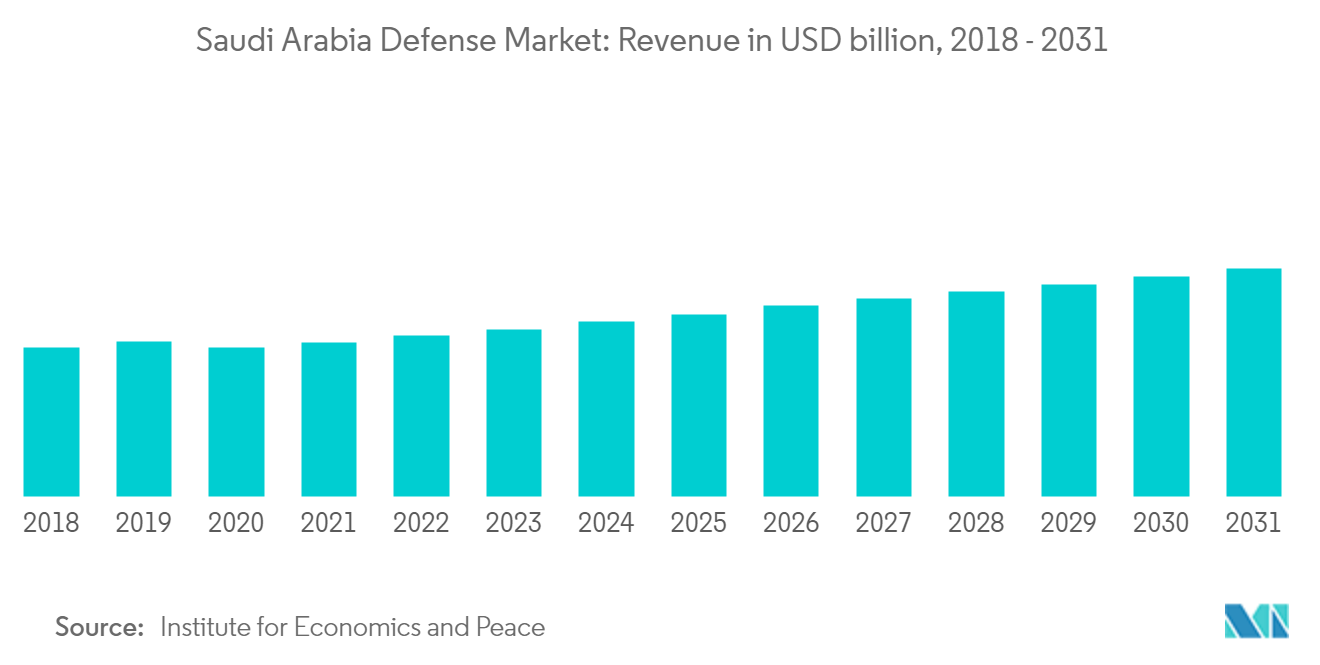
Sea-based Vehicles in the Vehicle Segment Expected to Register Significant Growth During the Forecast Period
The regional security environment increasingly emphasizes the importance of naval power. Navies have a front-line role in securing sea lines of communication to ensure freedom of navigation at sea, protecting exclusive economic zones and offshore assets. The navy also plays a crucial role in providing warning and engagement capabilities against air and missile attacks. Saudi Arabia is looking at capabilities to project naval prowess much further than it ever has. Intensifying international competition in the Red Sea on its western flank, Yemen’s implosion, and the Horn of Africa’s instability are significant trends redefining Riyadh’s maritime threat landscape beyond the Arabian Gulf. The government of Saudi Arabia has initiated the Saudi Naval Expansion Program II, a naval modernization program spanning more than 10 years. The government plans to spend approximately USD 20 billion on new ships (which may replace the outdated East Naval Fleet) and about USD 6 billion on the frigate program built by Lockheed Martin. SNEP II focuses attention on the Royal Saudi Navy’s Eastern Fleet, which last underwent a major modernization program in the 1980s and 1990s. It is largely driven by a need to counter Iranian naval power, which focuses on an ability to blockade critical maritime chokepoints, such as the Strait of Hormuz. Under this initiative, the country ordered Multi-Mission Surface Combatant Ships (MMSC). In December 2019, Lockheed Martin was awarded a USD 1.96 billion foreign military sales contract to design and construct four MMSC for the country. The delivery of the naval vessels is anticipated to begin by 2023. Similarly, the country is currently launching Avante corvettes manufactured by Navantia. Such robust procurements into the naval segment are anticipated to accelerate the market's growth during the forecast period.
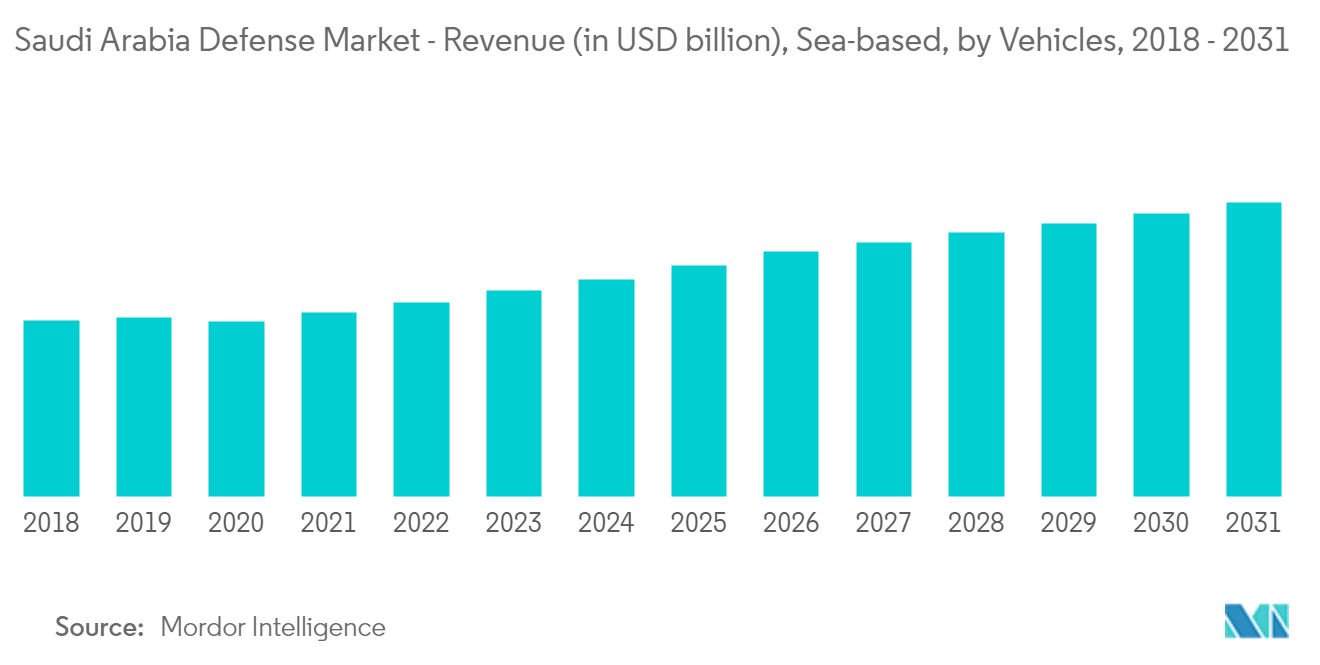
Saudi Arabia Defense Industry Overview
The market in the country is dominated by foreign players, mainly those from the United States. Notable companies among them include Lockheed Martin Corporation, the Boeing Company, and Raytheon Technology Company. For instance, in December 2021, under the Royal Saudi Air Force (RSAF) AWACS Modernization Program Phase 2, the country was awarded a contract worth USD 397.9 million to Boeing to modernize its fleet of Boeing E-3 Sentry Airborne Warning and Control System (AWACS) aircraft. Under the contract, the company will modernize five aircraft by 2026. However, the government is trying to develop its indigenous defense manufacturing capabilities. The Government of Saudi Arabia is focusing on implementing policies to ensure that its publicly held defense manufacturers account for more than 50% of its defense revenue share by 2030. In this regard, In February 2021, Saudi Arabian Military Industries (SAMI) signed an agreement to set up a joint venture with the US firm Lockheed Martin. This deal is expected to enhance the Kingdom’s defense and manufacturing capabilities and localize military industries. The venture is projected to develop capabilities in manufacturing and software technologies, systems integration, and the production, maintenance, and repair of rotary and fixed-wing aircraft and missile defense systems. SAMI will own 51% of the venture, while Lockheed Martin will hold the rest. Such initiatives may reduce the market share of foreign companies in the country during the forecast period.
Saudi Arabia Defense Market Leaders
Lockheed Martin Corporation
The Boeing Company
BAE System PLC
Saudi Arabian Military Industries
Raytheon Technologies Corporation
*Disclaimer: Major Players sorted in no particular order
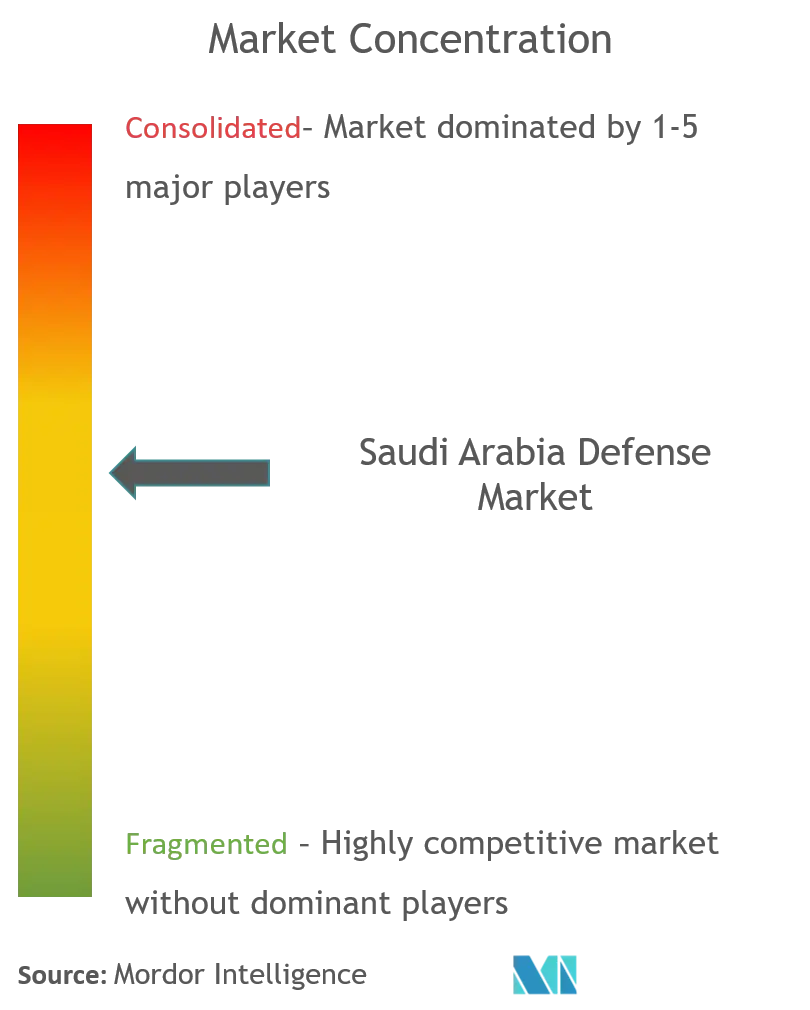
Saudi Arabia Defense Market News
- In December 2021, Saudi Arabian Military Industries (SAMI) launched two new joint ventures with French companies.
- The first joint venture was signed with Airbus (49% ownership) to provide maintenance, repair, and overhaul (MRO) and service provision for military aircraft. The company will commence operations in 2022 and initially support Airbus C295W transport aircraft and Airbus A330 Multi-Role Tanker Transport (MRTT).
- The second joint venture, SAMI Figeac Aero Manufacturing, will be established with Figeac Aero and the Saudi Arabian Industrial Investments Company. The company will manufacture titanium and aluminum components for military and commercial aircraft and helicopters. It will begin manufacturing by 2024.
- In February 2021, the Saudi Arabian Military Industries (SAMI) signed an agreement with NIMR, a UAE military vehicles manufacturer, to locally manufacture the JAIS 4x4 MRAP (Mine-Resistant Ambush Protected) vehicles in Saudi Arabia. The armored vehicles are planned to be manufactured in the United Arab Emirates by NIMR. Later, through the transfer of production and technology, SAMI may develop its supply chain capabilities to enable the two companies to manufacture all the JAIS vehicles in Saudi Arabia jointly.
Saudi Arabia Defense Market Report - Table of Contents
1. INTRODUCTION
1.1 Study Assumptions and Market Definition
1.2 Scope of Study
2. RESEARCH METHODOLOGY
3. EXECUTIVE SUMMARY
3.1 Market Size and Forecast, Global, 2018 - 2031
3.2 Market Share by Type, 2021
3.3 Structure of the Market and Key Participants
4. MARKET DYNAMICS
4.1 Market Overview
4.2 Market Drivers
4.3 Market Restraints
4.4 PEST Analysis
5. MARKET SEGMENTATION (Market Size and Forecast by Value - USD billion, 2018 - 2031)
5.1 Type
5.1.1 Personnel Training, Simulation, and Protection Equipment
5.1.2 Communication Systems
5.1.3 Weapons and Ammunition
5.1.3.1 Artillery and Mortar Systems
5.1.3.2 Infantry Weapons
5.1.3.3 Missile and Missile Defense Systems
5.1.3.4 Ammunitions
5.1.4 Vehicles
5.1.4.1 Land-based Vehicles
5.1.4.2 Sea-based Vehicles
5.1.4.3 Air-based Vehicles
6. COMPETITIVE LANDSCAPE
6.1 Company Profiles
6.1.1 Saudi Arabian Military Industries
6.1.2 Lockheed Martin Corporation
6.1.3 The Boeing Company
6.1.4 BAE Systems PLC
6.1.5 Raytheon Technologies Corporation
6.1.6 Northrop Grumman Corporation
6.1.7 General Dynamics Corporation
6.1.8 Leonardo SpA
6.1.9 Airbus SE
6.1.10 Almaz-Antei Corporation JSC
6.1.11 Thales Group
6.1.12 L3Harris Technologies Inc.
6.1.13 Navantia SA
7. MARKET OPPORTUNITIES AND FUTURE TRENDS
Saudi Arabia Defense Industry Segmentation
The Saudi Arabian defense market covers all the aspects of military vehicles, armament, and other equipment procurements, and it provides insights into budget allocation and spending.
The market has been segmented by Type into Personal Training, Simulation, Protection Equipment, Communication Systems, Weapons and Ammunition, and Vehicles. The market sizing and forecasts have been provided in value (USD billion).
| Type | ||||||
| Personnel Training, Simulation, and Protection Equipment | ||||||
| Communication Systems | ||||||
| ||||||
|
Saudi Arabia Defense Market Research FAQs
How big is the Saudi Arabia Defense Market?
The Saudi Arabia Defense Market size is expected to reach USD 15.25 billion in 2023 and grow at a CAGR of 4.09% to reach USD 18.63 billion by 2028.
What is the current Saudi Arabia Defense Market size?
In 2023, the Saudi Arabia Defense Market size is expected to reach USD 15.25 billion.
Who are the key players in Saudi Arabia Defense Market?
Lockheed Martin Corporation, The Boeing Company, BAE System PLC, Saudi Arabian Military Industries and Raytheon Technologies Corporation are the major companies operating in the Saudi Arabia Defense Market.
Saudi Arabia Defense Industry Report
Statistics for the 2023 Saudi Arabia Defense market share, size and revenue growth rate, created by Mordor Intelligence™ Industry Reports. Saudi Arabia Defense analysis includes a market forecast outlook to 2028 and historical overview. Get a sample of this industry analysis as a free report PDF download.
